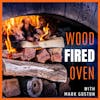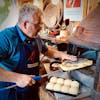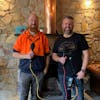Live Cook - Turkish Lahmacun in the Wood Fired Oven

Sometimes its nice to do something quick and easy in the wood fired oven. This week - I am cooking a Turkish inspired Lahmacun in my wood fired oven. This episode is a bit unique - as I am making this for the first time - live on the podcast!
Join me as I experiment with making something different!
You can grab this recipe at my website below.
The Fire Brick Company
The Fire Brick Company specialises in producing world class Wood Fired Pizza Oven Kits.
I am very grateful to the Fire Brick Company for sponsoring the show. If you are thinking of building your own Wood Fired Oven, head on over to The Fire Brick Company website - www.thefirebrickco.com/WFOpodcast where they have a little something for you.
Become a Supporter of the show
Please consider supporting the Wood Fired Oven Podcast. I am very grateful to all those who support the show. Every little bit helps to cover costs. Support the show here.
Leave a review
Please leave a review on Apple Podcasts to let me know what you think of the show.
My website
Check out my website for episode show notes and links, wood fired oven tips and advice, pictures and recipes: woodfiredoven.cooking
Social
Instagram: marks_WoodFiredOven
Facebook: Wood Fired Oven Chronicles Facebook group
YouTube: @woodfiredovenpodcast
Twitter: @WFOPodcast
Recommended Wood Fired Oven books
Check out my favourite books. They have helped me a lot, both with cooking in my wood fired oven and learning to cook with fire. Some of these have also been recommended to me by friends of my podcast.
Mark (00:07):
Gday - Welcome to the Wood Fired Oven podcast where I take a deep dive into the techniques, recipes and history of wood fired oven cooking. My name is Mark an obsessed and somewhat curious fan of outdoor cooking - especially with my wood fired oven. Follow my podcast in your favourite app and listen in, as I go searching for the best recipes, tips and ad vice, to both supercharge our cooking skills and motivate you to light up your favourite outdoor cooking gear this weekend.
Mark (00:43):
Gday and welcome to this episode. I really hope you've had a great week. In today's episode. I'm going to be doing a live cook. I'm going to be trying for the very first time to cook a Turkish inspired lahmacun in the wood-fired oven. Sometimes it's nice to do something nice and quick and easy in the wood-fired oven. And this week I'm going to be taking a look at this lovely Turkish inspired flat bread snack. This podcast is a bit unique as I'm making this for the very first time. Join me as I go experimenting with making something a little bit different, now depending on where you are in the world you probably pronounce this particular dish a little differently. The Turkish version of this word is pronounced Lamar Zune. I understand June at the end of it. I'm a Kiwi so we tend to say lahmacun, but I think we all know what we mean. For those of you listening in Turkey, and there are quite a number of you. Thanks so much for tuning in, by the way, what follows is my best efforts on making this gorgeous flatbread delight. I would love to hear from anyone in Turky who would like to share their own unique probably vastly superior version, with me, get in touch with me at my website.
Mark (01:55):
Okay. So for those of you who may not be aware, a lahmacun is a flat bread. It's a really, really thin flatbread and it's topped with ground meat and that's pretty much it. It's often cooked in a wood-fired oven. Well, you know, I'm a bit biased, it's got to surely be the best way. And when cooked for a minute or two, that's all it takes. It's in topped with fresh slices of tomato, flat leaf parsley, and a good squeeze of lemon juice. Sometimes other salad options are added as well, but I have only ever had this particular version that I'm going to do today. And I absolutely love it.
Mark (02:29):
And lahmacun basically means meat with dough and you'd think it would be pretty simple and tastes pretty plain, but it is amazing. You've absolutely got to try it once the toppings are on you basically roll the uncut Turkish pizza up like a rap and eat it. Yeah. Oops, just don't call it a Turkish pizza. It's really not a pizza as there's no cheese on it. It's a flatbread. It's a gorgeous flat bread. The lahmacun is very popular in Turkey. They are most often served on individual plates and that's how it was served to us at a fantastic Turkish inspired restaurant in Auckland New Zealand. The last time I had this, six or seven years ago, a few years ago, I made a tandoor oven with a couple of large terracotta flowerpots and it was amazing. I absolutely loved it. And I was able to cook a type of flatbread called Naan. And most of you would have heard of this type of bread. They are amazing. I love flatbreads. They're nice. They're light. They're really versatile. And they can accompany all sorts of different foods. Flatbreads generally in the middle east regions have always been cooked either in tandoors and on Tawas, which is a type of metal pan for thousands of years. Like I said, flatbreads are really versatile and because they are so thin, you can use them to wrap up other foods in them too. Now that's the genius. I think that's great. Super portable for kids' lunches and also taking to work. It's thought that with the designs of stone and brick ovens, that these flatbreads topped with meat, like our lahmacun started to be cooked together.
Mark (03:59):
Now, you would think that places like Istanbul in Turkey, you would have been making these for thousands of years. Well, no, interestingly it wasn't until the 1950s or so that this type of street food really took off and in Istanbul and became super popular. These days lahmacun is very popular all over the middle east and with good reason, it's absolutely delicious, very popular in Turkey as mentioned, Lebanon, Syria, Armenia Israel, and very popular in my household as well. I've popped up the ingredients and my cooking method on my website at WoodFiredOven.Cooking. So if you want to give this a go, please try it. But also let me know that you've given it a shot and share some pictures with me because I would love to hear how it's going for you.
New Speaker (04:40):
Okay. Come out to my backyard and join me, keep your fingers crossed. And my wood-fired oven as I cook up a large batch of these gorgeous flatbreads. Let's hope it works out okay. First time for everything. Okay. We're going to start by preparing the flat bread dough. Now I used about 320 odd grams of just plain white flour, sugar, yeast, and water to form a slightly wet dough. Now I'm not doing this in real time. I prepared this about four hours ago and that's around about the timeframe you're going to need to have the meat mixture and the dough already at the same time. So the ingredients for the dough about 500 grams of white bread flour in total, about a teaspoon of white sugar, six grams of fast action dry yeast is what I used. Yeah, you can use fresh yeast. I've never used fresh yeast before. If you can get your hands on some, maybe work out what you're going to need and try that instead. About 320 mils of room temperature water, 10 grams of salt, and about a tablespoon of olive oil. And that's really all there is to the dough. I mixed about 320 grams of the flour and the sugar yeast and the water.
Mark (05:52):
And we formed this slightly wet dough, mixed it all together by hand, and then covered it in a bowl, put it somewhere warm and allowed it to double in size. And that took a couple of hours to do that. Bit of a cold day here today. So after it had doubled the, basically added in the remaining flour, the salt and the olive oil, which I just drizzled in over the top, and then I used a mixer to do the next step. But if you prefer, you can get your hands dirty and kneed the dough with your fingers until it becomes smooth and stretchy. And look, this could take anywhere from a 10 to 15 minutes, maybe a little longer, you don't want to overdo it. But what you're looking for, with this dough is the stretch test really. So when you pull the dough apart with your fingers, you should about see through it. It should be almost translucent without breaking apart. Once you've got it to that stage of that development, you can then cover it and leave it for at least another hour. And the goal here again is to try to double in size. So once it's doubled in size, you're going to sprinkle some flour onto your bench and tip the dough out of the bowl. And I used a dough cutter and I divided it up into about 16 pieces. So you want to roll each of these into a ball, just like you are making a regular pizza dough and you want to stretch it, so that each side of the dough ball comes back into the center of the dough and what will happen to the top of the dough is it will become smoother and tighter, smoother and tighter as you keep working that.
Mark (07:25):
And, and you'll know when it starts to look and feel right. It's quite fun to do actually. Once you've got your 16 balls, you want to cover these again and let them rise one more time. Now I've got a proofing box. I pop them into the proofing box and put them on the bench, put the lid on and just let them rise for about 30 or 40 minutes, just to soften that dough back up again. And actually by the end of this, they puffed up quite nicely and they were looking really fantastic. What I like to do at this point is I like to roll them out really, really flat now and have them back into the proofing box on baking paper so they don't stick together. So they're all ready to go when we want to eat. So I rolled them out and I got a really, really thin, and it's a little tricky to do. I used a rolling pin, but if you get it really, really thin in the oven, it means that you'll be able to roll up the lahmacun. Most pizza, you don't roll it , do we. We put it in the oven, we take it out, we cut it, we eat it all flat. The lahmacun historically, typically, gets rolled up. So it's a real flatbread you're looking for, so you've got to roll the dough really flat. So I put a little bit of flour into the proofing box, I put some baking sheets down and every bowl that was rolled out, had a baking sheet put on the top of it, and then basically what I've got right now is a stack of pre-prepared Lahmacun dough all rolled out in my briefing box ready to go. And it's just going to sit there for a bit while I prepare the rest of the ingredients.
Mark (08:53):
So it's time to prepare the meat topping. Now this isn't particularly difficult to do, but there are a few processes that we want to get right. I've got four medium tomatoes here. I'm cutting these in half, and then I'm going to get a spoon and I'm going to scoop out all of the centers of these tomatoes and discard that watery center. The reason you want to do that is when you put the topping on top of the dough, you want it as dry as possible. You don't want a wet dough, which is just going to soak through to the floor of the oven and get stuck and disintegrate. So all of these tomatoes are going to get scooped out. They're going to then be chopped, really finely, so you're getting them probably around two, maybe three millimeter, little bits of tomato. I'm not the great slicer chopper in the world, but it's quite good to get this done right. So I've now diced up all the tomatoes. I'm popping them into a sieve over the sink so that all the juices will work their way out. Okay, I've got one gorgeous large red onion here. And then I'm going to dice up as small as I can again. I just love red onions, my gosh, this is gorgeous. If you can't get your hands on red onions, obviously you could use a standard white onion. Once this is diced up, you're going to put all of this into the sieve as well or colander. And you're just going to let the ingredients drain away any excess moisture into the sink. Remember we want a really dry mixture as dry as we can. Oh, I got a few tears again from these onions, their pretty fresh onions and all those chemicals are getting into my eyes.
Mark (10:52):
Okay, I've got three or four cloves of garlic here that I'm going to peel and slice really, really finely. And I'm going to add those to the sieve. I've got one large green bell pepper and a large red bell pepper. I'm cutting each of these in half. I'm just going to use half each, scooping out all the seeds and all the membranes from the inside of the peppers. And once again, dicing the peppers up as small as you can. It's interesting how much moisture the flesh of the peppers still hold. And then it starts to release a little bit as you cut through them. Gonna add that diced peppers to the sieve as well. So I'm just working all the mixture now, the tomatoes, the onions, the capsicums, the bell peppers, just mixing those through the sieve now just trying to get any excess moisture out. So actually it looks like this sieve about to overflow, so I'm just getting a larger colander, popping that into the sink and putting all of these gorgeous, fresh ingredients into a larger collander to continue draining away for a few more minutes. Definitely some moisture still coming out of all of this, and it's good to get it out now.
Mark (12:08):
Okay. I've got a large pack of flat leaf parsley here. I'm taking a big bunch of it off and chopping that nice and fine. And cutting into those parsley. Wow. It releases the oils, the smells straight away. I'm getting this beautiful kick of the smell satisfaction just from the parsley. It's fantastic. And I'm going to mix all that through, into the ingredients in the colander, and now it's time to get ready for the meat of this dish. So I've got about three to 400 grams of lamb mince, and about the same of beef mince or ground beef, ground lamb, half and half. If you can't get lamb, just do it all beef. And I'm putting that into a large food safe container, mixing these two meats around combining them well, before I add the other ingredients, I've got around about a teaspoon of chili paste, I'm going to add into the beef. I've got a couple of tablespoons of tomato paste, going to sprinkle over about, about a teaspoon and a half or so of salt. And I'm going to get some freshly ground black pepper as well. Round about a teaspoon or so, love black pepper. Now I'm just slicing up a lemon, slicing that in half and squishing all of the juice of this whole lemon out over the meat.
Mark (13:34):
It sounds good. And it smells amazing. I just love working with fresh ingredients. It's just such a privilege. All of these ingredients today, the parsley, the onions, the garlic, the bell peppers. It's just the whole thing smells so gorgeous and fresh. And that's one of the key takeouts of this particular dish. It is such a light, fresh dish. It is so gorgeous. Now getting my hands dirty, mixing all this through. I'm now adding in the colander full of ingredients into the container with the meat and mixing this all through. And this takes a minute or two to really combine everything really, really well. And now you'll see the benefit of cutting everything nice and small. It's easy to mix. If you've got big chunks in there, it's not so great, but this mix in front of me looks pretty good. Could have got the bell peppers a little smaller probably, but it still looks great.
Mark (14:31):
One thing that surprises me in making lahmacun is the lack of actual spices that gets added to the meat. And you would think that a dish like this, you might have a bit of coriander, bit of cumin, bit of fennel perhaps, just to make that a bit more interesting, but you know, researching this recipe online from a large number of sources, really, it boiled down to a very, very simple meat topping mixture. Definitely chili's, definitely salt, definitely pepper, but the real star of the show aside from the meat ultimately is the fresh tomatoes and the lemon juice and the parsley that gets applied at the end, keeping this dish really light and really fresh, I think is really important. And if you over flavor the meat at this point, you're going to take away I think some of that freshness that this dish, this gorgeous lahmacun is well-known for.
Mark (15:25):
So try it without adding too much other stuff into it first and see what you think. Okay. So I'm just going to whiz it through now, blitz it just for a few seconds in the food processor, just to make it a little paste like, not really smooth. You still want it a little bit chunky, but there's certainly going to make it a lot easier to smooth onto the dough with a back of a spoon or your fingers shortly. Yeah now that's looking great. I don't want to do any more. That's perfect. I'm now putting the lid on and it's going to pop into the fridge for probably an hour just to allow those combinations of ingredients to merge together.
Mark (16:01):
Okay. So I'm now in front of the oven here, I've got all my ingredients with me. I've got the proofing box full of prepared dough. I've got the container full of the whizzed up ingredients, just got a little bit of semolina. I'm just going to pop that down onto the pizza peel. So I've got one of the flat bread rounds here. That's gone down on top of the semolina, on top of the pizza peel, and I'm just grabbing some of the meat mixture, putting it into the centre now and gently pressing it to the sides. That's really great. Oh my gosh. And I'm pushing the dough to the edges and it is looking nice. A whole dough top is now covered with a really thin, and it has to be thin layer of the meat mixture.
Mark (16:45):
I've had my wood-fired oven on for about two and a half hours, it is roaring in there. I've moved the fire to the right hand side of the oven, and that means I've got plenty of workspace in the centre of the oven to work. I've cleaned it with a brush to get all the ash to the back of the oven. And then I've wrapped a pizza peel. And I a wet towl and use that as a mop inside the oven to get any of the remaining ash and dust off the floor. So when I put these in, it's super clean and you're not going to get all of this ash stuck to your pizza, lahmacun, not pizza, lahmacun. Okay so its now been slid into the oven and oh, you can even hear it sizzling in the background there. Boy is that smelling good. It's not going to take very long to cook this through the lamb itself. It might take 90 seconds, couple of minutes. You don't want to overdo the base at the same time, because then it's very difficult to roll up Families outside this afternoon, it's a, it's a lovely, cool afternoon here where I am. And it's such a lovely day to have fire roaring beside me here as I'm smelling these gorgeous lahmacuns cooking. Oh my gosh, that's fantastic. I've already prepared some sliced tomatoes and diced up some parsley. I've got some lemon slices beside me as well. When this comes out of the oven through the centre, I'm going to be putting the parsley, the tomatoes and drizzling a whole bunch of lemon in the centre, going to roll it up and eat it. And that's it. It's super simple.
Mark (18:14):
So I've got about 16 of these to cook through, one of the things I do like to do, and I do this sometimes with pizza as well as I get the pizza peel underneath the lahmacun here, just doing it now, the bottom looks really nice. It's just checkered on the bottom. It's gorgeous. Hasn't risen too much, which is good. It's nice and thin. I'm just lifting the lahmacun on the peel up towards the dome of the oven now. So it's off the floor on the peel. And thats just to allow for some of that really high heat that is in the brickwork to come down on top of the lahmacun and just to help cook the mixture through just a little bit for a couple of seconds. And you can hear the uptake in the sizzling as that meat mixture really cracks on with that heat from the dome. Now that's just great. Taking a little peek at that now, and that's looking really, really nice, yeah I really want to do anymore. I think that'll do. I'm going to bring that out now onto the landing.
Mark (19:11):
Oh, here we go. Okay. I've got the tomatoes. I'm laying those down through the centre now, the parsley, it smells great. Laying that through the centre, the families chomping at the bit to get their mouths around some of these. It's actually been a few years, like I said, at the start of this podcast, since I've had lahmacun, back in New Zealand. Man it absolutely smells amazing. It looks fantastic. We're going to just serve these up to the kids. And then we're going to tuck into these ourselves. Thank you so much for joining me, my wood fired oven, out of my backyard on this rather cool Saturday afternoon. Stay safe, have fun and go cook with fire.
Mark (19:54):
If you’ve enjoyed this episode, please make sure you follow the Wood Fired Oven podcast in Apple Podcasts, Spotify or your favourite podcasting app. Please consider posting a review on apple podcasts…as that really helps the show. Don’t forget to check out WoodFiredOven.Cooking for more tips, tricks and advice on cooking with fire. You can also see full episode notes and links. You can also post a question which I may feature on the show. I’m also on Instagram, twitter and facebook so head over to your favourite social platform and and get in touch. Thanks again for listening. Catch you next time.
New to the Wood Fired Oven Podcast?
If you are a new listener to the show, take a listen to these featured podcast episodes to get you started! You can also check our my episodes by topic or season.












